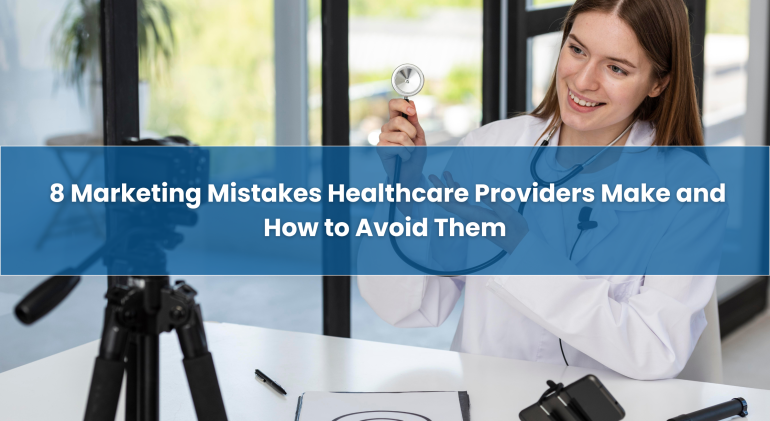
8 Marketing Mistakes Healthcare Providers Make
Healthcare has gone digital—and fast. With 100 billion healthcare searches on Google every year, today’s patients expect quick answers, personalized experiences, and professional online reputations. And when 84% of them rely on both online and offline research to choose a provider, your digital footprint is as critical as your clinical expertise.
Digital ad budgets reflect this urgency. Spending in healthcare marketing is predicted to jump from $15.84 billion to almost $20 billion, as more practices race to catch up. But spending more doesn’t mean succeeding—healthcare digital marketing mistakes in your strategy can do more harm than good.
From ignoring SEO to mishandling patient reviews, many providers make the same avoidable errors. This blog highlights the 8 most common medical marketing mistakes in healthcare—and how a few smart changes can bring big wins for your practice.
1.Ignoring Your Online Presence

Your website is your clinic’s first impression and in Google’s world, it’s everything— if it’s clunky, confusing, or not mobile-ready, patients won’t stick around.
How to Avoid It:
- Deploy a high performance, SEO-optimized website that executes swift delivery and intuitive user control.
- Key information like services, booking, location, and contact details should always be just one click away.
- Routinely audit your content and scan for outdated or broken hyperlinks.
2.Not Defining a Target Audience
One of the most basic (but most damaging) mistakes is trying to market to “everyone.” Not all patients are the same. A pediatric clinic and a senior care facility serve completely different crowds—your messaging better be sharp enough to match that.
How to Avoid It:
- Segment your audience by pinpointing vital demographics—such as age, gender, geographic locale, clinical diagnosis, and fiscal bracket—that resonate with your service capabilities.
- Identify your ideal patients’ challenges, needs, and health targets of your focus group to engineer a precision-driven intervention plan.
- Use trusted platforms and precise messaging that hits on each group’s specific pain points.
3.Not Leveraging Patient Reviews

Patient testimonials and reviews build credibility. Yet many healthcare providers either forget to collect reviews or ignore them altogether—especially the negative ones.
How to Avoid It:
- Actively request reviews from gratified patients via SMS or email.
- Claim and update your listings on platforms like Google Business Profile, Healthgrades, and Practo.
- Respond professionally to all reviews—both positive and negative—to show you care.
4.Ignoring Local SEO
If you’re not optimizing for local search, you’re missing out on patients searching for “dentist near me” or “pediatrician in [your city]”.
How to Avoid It:
- Target regional traffic by using location-based keywords in your on-site text and meta information.
- Inconsistent directory info damages trust—keep your clinic’s name, address, and number the same across all sites.
- Encourage satisfied patients to leave reviews with local references.
5.Overlooking the Need for Customer Education
Many healthcare websites are either too technical or too vague. Patients are looking for answers, not medical jargon.
How to Avoid It:
- Create an educational blog that distills advanced medical knowledge on ailments, remedial procedures, and wellness tips.
- Utilize graphical representations, videos, or short reels to simplify intricate topics.
- Focus on value—address your audience’s concerns with precision, guaranteeing recurrent engagement.
6.Lack of a Strong Call-to-Action
You’ve grabbed attention—but now what? Many providers forget to guide the patient on the next step.
How to Avoid It:
- Stop messing around. Every page, email, or post MUST have a CTA like “Book Your Appointment,” “Call Us Now,” or “Download Our Guide.”
- Use bold buttons or links and make sure they work across all devices.
- Keep your CTAs action-oriented and relevant to the content.
7.Not Claiming or Updating Online Listings

Google My Business, Healthgrades, Practo, and similar platforms often show outdated or incorrect contact details. This leads to missed appointments and a lack of trust.
How to Avoid It
- Claim your listings on all relevant directories, verifying that all information remains rigorously aligned and accurate.
- Add high-quality images, hours of operation, and links to your website and booking page.
- Respond to reviews to show you’re active, accountable, and value patient feedback.
8.Using Too Much Medical Jargon in Marketing
Patients aren’t medical professionals. Using complex terminology can alienate them and make your brand seem cold or hard to relate to.
How to Avoid It
- Write like you speak—clear, conversational language resonates more with everyday patients
- Break down procedures or conditions using analogies, visuals, or Q&A formats.
- Test your content readability with tools like Hemingway or Grammarly to ensure clarity.
Avoid These Mistakes—Partner With SnapDigital Solutions for Smarter Healthcare Marketing
Mistakes in healthcare digital marketing don’t just cost you patients—they hurt your credibility. If you’re still making these eight errors, you’re falling behind. But here’s the good news: every mistake can be turned into a growth opportunity with the right marketing strategies for private practices and execution.
Snap Digital Solutions offers the best digital marketing services in the UK for healthcare providers, helping you boost your online reputation and run ROI-focused campaigns that get you noticed—and trusted.
Start marketing smarter today by choosing Snap Digital Solutions, your trusted partner for digital marketing services in the UK.






